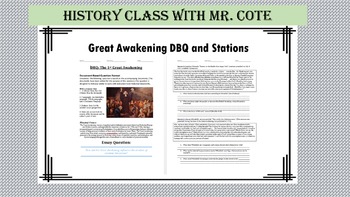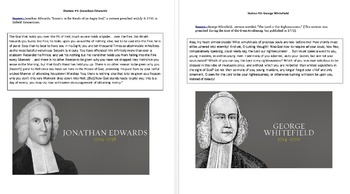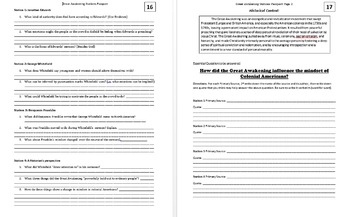The 1st Great Awakening DBQ and Stations
Zachary Cote
51 Followers
Grade Levels
8th - 11th
Subjects
Resource Type
Standards
CCSSCCRA.R.1
CCSSCCRA.R.2
CCSSCCRA.R.4
CCSSCCRA.R.9
CCSSCCRA.W.1
Formats Included
- Zip
Pages
10 pages
Zachary Cote
51 Followers
What educators are saying
This was wonderful for my students. Having them do a DBQ on something interesting like the Great Awakening really helped them understand what was going on during this time period.
This was a great resource to break down information for students and to aid them in learning how to write a DBQ for APUSH.
Description
Students are asked to answer the question, "How did the Great Awakening influence the mindset of Colonial Americans?" using 4 sources. 3 are primary sources from the era, and 1 is an excerpt from a Journal Article by two modern historians.
This file comes with 2 options:
1) A traditional DBQ with 3 guiding questions per document to help the students toward their own thesis, with a page to record a quote that can be used as evidence in the essay.
2) A "Stations Packet" if the teacher wants this to be more of a classwork activity rather than an assessment. Each source has its own page and the students have 2 "passports" with the questions. This format is great for doing collaborative work on the documents.
**** Answer Key for all Questions is at the end of this file. *******
The purpose of this DBQ/activity, is to get the students thinking about how there was more of a mental mindset on the individual and personal conviction, which would eventually connect to some underlying reasons for the American Revolution.
This file comes with 2 options:
1) A traditional DBQ with 3 guiding questions per document to help the students toward their own thesis, with a page to record a quote that can be used as evidence in the essay.
2) A "Stations Packet" if the teacher wants this to be more of a classwork activity rather than an assessment. Each source has its own page and the students have 2 "passports" with the questions. This format is great for doing collaborative work on the documents.
**** Answer Key for all Questions is at the end of this file. *******
The purpose of this DBQ/activity, is to get the students thinking about how there was more of a mental mindset on the individual and personal conviction, which would eventually connect to some underlying reasons for the American Revolution.
Total Pages
10 pages
Answer Key
Included
Teaching Duration
3 days
Report this resource to TPT
Reported resources will be reviewed by our team. Report this resource to let us know if this resource violates TPT’s content guidelines.
Standards
to see state-specific standards (only available in the US).
CCSSCCRA.R.1
Read closely to determine what the text says explicitly and to make logical inferences from it; cite specific textual evidence when writing or speaking to support conclusions drawn from the text.
CCSSCCRA.R.2
Determine central ideas or themes of a text and analyze their development; summarize the key supporting details and ideas.
CCSSCCRA.R.4
Interpret words and phrases as they are used in a text, including determining technical, connotative, and figurative meanings, and analyze how specific word choices shape meaning or tone.
CCSSCCRA.R.9
Analyze how two or more texts address similar themes or topics in order to build knowledge or to compare the approaches the authors take.
CCSSCCRA.W.1
Write arguments to support claims in an analysis of substantive topics or texts, using valid reasoning and relevant and sufficient evidence.




